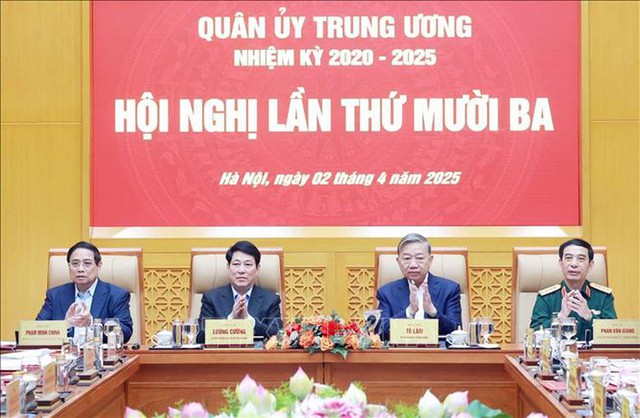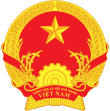Central Military Commission mulls over re-organization of local armed forces
VGP – The Central Military Commission convened a meeting on Wednesday to deliberate on a project on re-organization of local-level armed forces in the new situation.

From left to right: Prime Minister Pham Minh Chinh; President Luong Cuong; General Secretary, Secretary of the Central Military Commission To Lam, Minister of National Defense, Vice Secretary of the Central Military Commission Phan Van Giang at the 13th meeting of the Central Military Commission, Ha Noi, April 2, 2025. Photo: VGP
General Secretary To Lam, Secretary of the Central Military Commission, presided over the meeting.
Participants to the meeting include Politburo member, President Luong Cuong; Politburo member, Prime Minister Pham Minh Chinh; Politburo member, Minister of National Defense, Vice Secretary of the Central Military Commission Phan Van Giang.
Addressing the meeting, General Secretary To Lam stressed that the re-organization of local-level armed forces must be consistent with the country's defense and military strategies and policies.
He reiterated the principle of ensuring the Party's absolute and direct leadership over the Viet Nam People's Army (VPA) – the core force in firmly safeguarding the Fatherland.
The re-organization of local-level armed forces aims to enhance the efficiency, reduce intermediary levels, and strengthen their core role in implementing the people's defense strategy, he said.
General Secretary To Lam is leading a revolution in streamlining the political system, describing it as an "imperative for life" as Viet Nam is on the threshold of new era – the era of the nation's rise.
From that perspective, the political system must be rearranged and streamlined before the Party congresses at all levels scheduled this year, towards the 14th National Party Congress early next year.
The move only targets to save budget for investment but also helps improve the efficiency and effectiveness of the State apparatus, the Party leader stressed.
Over the past few months, Viet Nam has completed the streamlining and re-organization of Party agencies and Cabinet ministries.
For Party agencies, the Party Central Committee decided to end the operation of the Central Commission for External Relations and transfer the its functions and tasks to the Ministry of Foreign Affairs.
The Party Central Committee decided to end the operation of the Party Committee of the Central Agencies Bloc, the Party Committee of the Central Enterprises Bloc, the Party delegations and Party executive committees at central and provincial levels.
The Party Central Committee decided to establish four Party Committees directly under the Party Central Committee: The Party Committee of the Central Party Agencies; the Party Committee of the National Assembly, the Party Committee of the Government, the Party Committee of the Fatherland Front of Viet Nam and central mass organizations.
The Party Central Committee decided to establish the Central Commission for Communication, Education and Mass Mobilization by merging the Central Commission for Communication and Education and the Central Commission for Mass Mobilization.
The Party Central Committee decided to supplement new functions and tasks to the Central Economic Commission and change its name to the Central Policy and Strategy Commission.
For the legislative branch, the National Assembly ended the operation of the Committee for External Relations and transferred its tasks to the Committee for National Defense and Security, the Office of the National Assembly, and the Ministry of Foreign Affairs.
The National Assembly renamed the Committee for National Defense and Security as the Committee for National Defense, Security and External Relations.
The National Assembly set up the Law and Judicial Committee by merging the Law Committee and the Judicial Committee; set up the Economic and Financial Committee by merging the Economic Committee and the Finance-Budget Committee; set up the Culture and Social Affair Committee by merging the Social Affair Committee and the Culture Committee.
For the executive branch, the Government merged the following ministries: The Ministry of Planning and Investment and the Ministry of Finance; the Ministry of Transport and the Ministry of Construction; the Ministry of Agriculture and Rural Development and the Ministry of Natural Resources and Environment; the Ministry of Information and Communications and the Ministry of Science and Technology; the Ministry of Labor-Invalids and Social Affairs and the Ministry of Home Affairs.
The Government set up the Ministry of Ethnic Minorities and Religions on the basis of the Committee for Ethnic Minority Affairs receiving functions, tasks and structural organization from the Ministry of Home Affairs.
In the next few months, Viet Nam will continue to merge dozens of provinces and centrally run cities to reduce the number of localities to around 34 from current 63; abolish district-level administrations; and reduce the number of communes to about 5,000 from current 10,595.
Local administrations will be reorganized into two levels (provincial and grassroots levels) instead of current three levels (provincial, district and communal levels) to create a two-tier local governance to ensure streamlined, efficient and effective operations.

